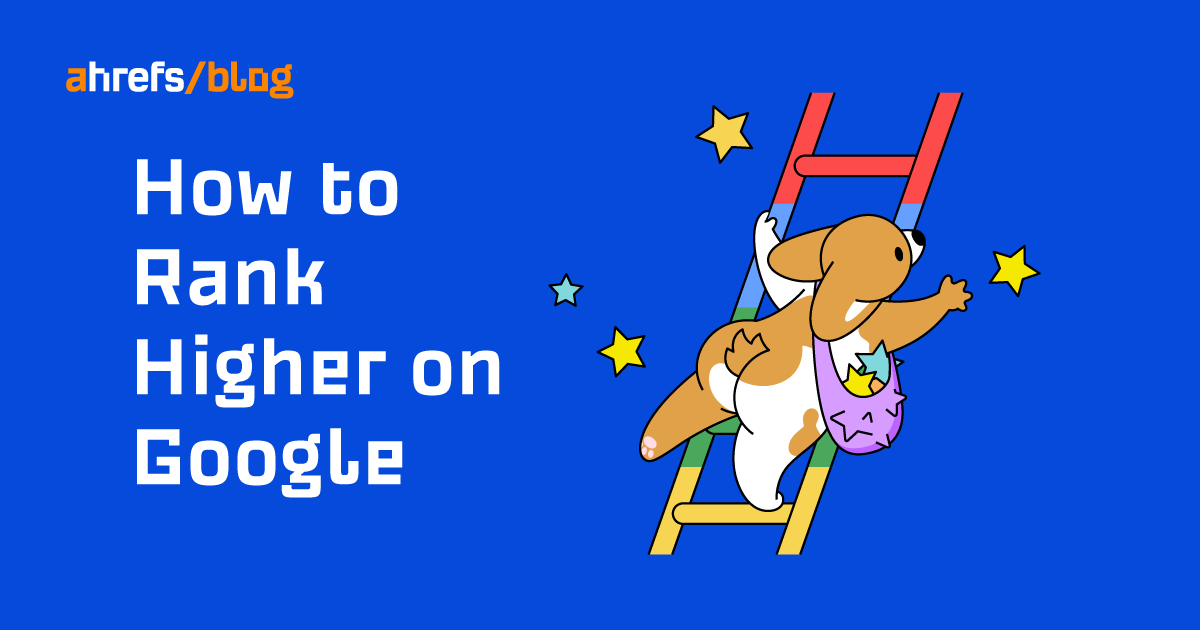SEO
How to Rank Higher on Google (10 Steps)

Hundreds of factors could improve your Google rankings. But some are more difficult to influence than others.
For that reason, if you want to rank higher, you need to be methodical. Start by working on the easy things that are within your control, then move on to more challenging things if needed.
Here’s the process:

Before we get started…
The process in this guide works best for internal pages. If you want to rank your homepage, read our guide to homepage SEO. If you run a local business and want to rank in local search, read our guide to local SEO.
If you already know which keyword you want to rank higher for, skip this step. Otherwise, you need to find a page that could rank higher for its target keyword.
Here’s an easy way to do this:
- Paste your domain into Ahrefs’ Site Explorer
- Go to the Organic keywords report
- Filter for rankings in positions 2–10
You should now see all keywords you rank for on the first page of Google, but not in position #1. All you have to do is choose one.

Here’s a tip: look for your main keyword targets for the corresponding page.
For example, our guide to learning SEO ranks in position #10 for “how long does it take to learn SEO.” But this isn’t the primary target keyword for the page, so it’s likely not the best one to try to improve rankings for.

Recommendation
If you don’t have any first-page rankings, try to rank higher for keywords on page two or three. It’s usually easier to improve rankings for pages that are already doing quite well. But if you don’t have any, improving rankings on page two or three is your best bet.
Search intent is the “why” behind the query. It’s why 90% of the top-ranking results for “air fryer” are blog posts and not sales pages. Google understands that searchers aren’t ready to buy. They want to compare products.

You need to align your page with search intent to stand the best chance at ranking.
We learned this the hard way when trying to rank for “backlink checker.”
Here’s the page we first created:

You can see that it explains how to check a site’s backlinks with Ahrefs and offers searchers a free trial.
This performed OK and ranked for years in positions #6–10—but it never cracked the top five.
In 2018, we realized this was a search intent issue. All the top-ranking pages for “backlink checker” were free tools.

To solve this, we added a free tool to the page. Almost overnight, the page shot to #1—and it’s been there ever since.

To see how well your page aligns with intent, check the top-ranking pages for the three Cs:
- Content type – Are they mainly blog posts, product, category, landing pages, or something else?
- Content format – Are they mainly tutorials, listicles, how-to guides, recipes, free tools, or something else?
- Content angle – Is there a dominant selling point, like low prices or how easy it is?
For example, all the top-ranking pages for “pancake recipe” are blog posts with recipes. And the dominant selling point is how easy they are to make.

Even if your content aligns with search intent, you may not be giving searchers everything they want. There may be subtopics they’re looking for and expecting you to cover.
For example, most top-ranking results for “how to write a press release” are how-to blog posts. This paints a clear picture of search intent.

But if you look at these posts, most of them include a template or links to templates.


Google likely knows that searchers value posts with templates more than those without, so you should probably include one if you want to rank higher for this keyword.
Here are a couple of ways to find subtopics to include in your content:
- Eyeball the top-ranking pages for commonalities – Pay particular attention to subheadings.
- Find keywords top-ranking pages rank for that you don’t – These often map to subtopics.
Here’s how to do the latter in Ahrefs’ Site Explorer:
- Paste your page into Site Explorer
- Go to the Content Gap report
- Paste in a few top-ranking URLs
For example, here’s what we get if we plug in our post about creating a go-to-market strategy.

Freshness is a query-dependent Google ranking factor. If searchers are likely to value updated content, Google ranks fresh pages higher.
For example, people value freshness when searching for “top google searches.” They want the most popular Google searches right now, not 10 years ago. That’s why rankings and traffic for our page drop when the content becomes stale and jump back up when we update the page.

If you’re unsure whether Google values freshness, check the dates on top-ranking pages.
For example, all top-ranking results for “best headphones” were updated recently. But many top-ranking results for “best parks in london” haven’t been updated for months or even years. This doesn’t matter because it’s not like new parks are built daily.


If freshness is important for your keyword, you may rank higher by refreshing your page.
Making the purpose and relevance of your page clear to Google and searchers is the job of on-page SEO. It’s the icing on the cake that highlights the work you put into matching intent and covering the topic in full.
Here are a few simple ways to improve your on-page SEO:
- Use H1–H6 tags to structure your content hierarchically – Google recommends this. Wrap your title in an H1, subheadings in H2s, sub-subheadings in H3s, etc.
- Use a short, descriptive URL – Google says simple URLs convey content information.
- Write a compelling title tag and meta description – This may help you get more clicks and send positive signals about your content to Google.
- Optimize your images – Google says to use brief but descriptive filenames and alt text. It’s also worth compressing images to improve page speed—which is a ranking factor.
- Polish your copy – Google says users enjoy content that’s well written and easy to follow. Use short paragraphs, good grammar, and proven copywriting techniques to keep readers engaged.
Learn more: On-Page SEO: Complete Beginner’s Guide
Internal links are links from one page on your website to another. They’re important because they’re how PageRank flows around your site. In other words, internal links boost a page’s authority and tell Google it’s important.
Here’s an easy way to find relevant internal link opportunities:
- Sign up for a free Ahrefs Webmaster Tools account
- Crawl your website with Site Audit
- Go to the Internal link opportunities tool
- Set the target URL to the page you want to rank higher
This tool takes all the keywords your target page ranks for in the top 100 and finds mentions of them on your site. It then suggests them as contextual internal link opportunities.
For example, suppose we set our guide to building a content marketing strategy as the target page. In that case, there are 13 potential internal link opportunities.

Here’s one of them:

Here, it’s suggesting that we internally link the phrase “content marketing strategy” in our list of content marketing tools.
Internally linking this phrase may help our post to rank higher.
If you don’t see any results in this report, it’s either because:
- Your target page doesn’t rank in the top 100 for any keywords.
- You don’t mention any of the keywords it ranks for on your site.
Either way, you can find opportunities in Google by searching for site:domain.com "".
For example, there are plenty of mentions of “content marketing strategy” on our blog.

Having many similar pages about the same thing is shooting yourself in the foot. That’s because backlinks get spread between pages and are a ranking factor. So you can end up with many weak pages instead of one strong enough to rank.

To solve this problem, redirect weaker pages about a topic to the strongest one. This consolidates backlinks and creates a page more capable of ranking.

To find pages on your site about the keyword you want to rank higher for, search Google for site:domain.com .
For example, our site has two very similar pages about meta keywords. We have a blog post explaining meta keywords and a glossary page that does the same thing.

Redirecting one of these to the other to consolidate backlinks may help us rank higher for this keyword. It creates one stronger page from two weaker pages.
Recommendation
Keep search intent in mind when doing this. If your pages fulfill different intents, redirecting may not be the best idea. This tactic is best when pages are very similar.
Backlinks are one of Google’s most important ranking factors. Andrey Lipattsev, a search quality senior strategist at Google, confirmed this in 2016.
Unfortunately, building high-quality backlinks is one of the most challenging parts of SEO. This is because it’s not something you can fully control. You have to create something worthy of earning backlinks, then convince people to link to you.
This is why it’s the final step in our process.
Here’s a good starting point if you’re new to link building:
- Paste a competing page into Site Explorer
- Go to the Backlinks report
- Look for backlinks you may be able to replicate
For example, let’s say we want to build links to our beginner’s guide to SEO. If we search Google for competing pages with the Ahrefs’ SEO Toolbar installed, we’ll find that one has links from over 14K referring domains.

According to Ahrefs’ Site Explorer, here’s one of the pages it got a backlink from recently:

Looking at the referring page, it seems the link comes from a section listing three of the best SEO guides.

If we reach out to the author and introduce our beginner’s guide to SEO, there’s a chance they may add it to their page.
Rank tracking is the only way to know if your efforts to rank higher on Google are working.
Although you can do this for free by searching on Google, it isn’t usually reliable. This is because factors like location and search history can affect where you see a page ranking. Using a rank tracking tool like Ahrefs’ Rank Tracker is much more accurate.
You can track 10K keywords in this tool, but you only usually need to track the main keyword for each page.
Hit the graph caret next to any keyword in Rank Tracker to see its ranking progress over time.

Ranking high on Google for one keyword is great, but ranking high for many keywords is even better. So once you’ve followed this process for one keyword, repeat it for more.
You’ll rank higher for hundreds of keywords and get tons of organic traffic before you know it.
Final thoughts
You can do many things to rank higher on Google, but it makes sense to start with the easy ones that are within your control. If those don’t move the needle, invest in more challenging things like link building.
Give me a shout on Twitter if you have any questions.
SEO
Google Cautions On Blocking GoogleOther Bot

Google’s Gary Illyes answered a question about the non-search features that the GoogleOther crawler supports, then added a caution about the consequences of blocking GoogleOther.
What Is GoogleOther?
GoogleOther is a generic crawler created by Google for the various purposes that fall outside of those of bots that specialize for Search, Ads, Video, Images, News, Desktop and Mobile. It can be used by internal teams at Google for research and development in relation to various products.
The official description of GoogleOther is:
“GoogleOther is the generic crawler that may be used by various product teams for fetching publicly accessible content from sites. For example, it may be used for one-off crawls for internal research and development.”
Something that may be surprising is that there are actually three kinds of GoogleOther crawlers.
Three Kinds Of GoogleOther Crawlers
- GoogleOther
Generic crawler for public URLs - GoogleOther-Image
Optimized to crawl public image URLs - GoogleOther-Video
Optimized to crawl public video URLs
All three GoogleOther crawlers can be used for research and development purposes. That’s just one purpose that Google publicly acknowledges that all three versions of GoogleOther could be used for.
What Non-Search Features Does GoogleOther Support?
Google doesn’t say what specific non-search features GoogleOther supports, probably because it doesn’t really “support” a specific feature. It exists for research and development crawling which could be in support of a new product or an improvement in a current product, it’s a highly open and generic purpose.
This is the question asked that Gary narrated:
“What non-search features does GoogleOther crawling support?”
Gary Illyes answered:
“This is a very topical question, and I think it is a very good question. Besides what’s in the public I don’t have more to share.
GoogleOther is the generic crawler that may be used by various product teams for fetching publicly accessible content from sites. For example, it may be used for one-off crawls for internal research and development.
Historically Googlebot was used for this, but that kind of makes things murky and less transparent, so we launched GoogleOther so you have better controls over what your site is crawled for.
That said GoogleOther is not tied to a single product, so opting out of GoogleOther crawling might affect a wide range of things across the Google universe; alas, not Search, search is only Googlebot.”
It Might Affect A Wide Range Of Things
Gary is clear that blocking GoogleOther wouldn’t have an affect on Google Search because Googlebot is the crawler used for indexing content. So if blocking any of the three versions of GoogleOther is something a site owner wants to do, then it should be okay to do that without a negative effect on search rankings.
But Gary also cautioned about the outcome that blocking GoogleOther, saying that it would have an effect on other products and services across Google. He didn’t state which other products it could affect nor did he elaborate on the pros or cons of blocking GoogleOther.
Pros And Cons Of Blocking GoogleOther
Whether or not to block GoogleOther doesn’t necessarily have a straightforward answer. There are several considerations to whether doing that makes sense.
Pros
Inclusion in research for a future Google product that’s related to search (maps, shopping, images, a new feature in search) could be useful. It might be helpful to have a site included in that kind of research because it might be used for testing something good for a site and be one of the few sites chosen to test a feature that could increase earnings for a site.
Another consideration is that blocking GoogleOther to save on server resources is not necessarily a valid reason because GoogleOther doesn’t seem to crawl so often that it makes a noticeable impact.
If blocking Google from using site content for AI is a concern then blocking GoogleOther will have no impact on that at all. GoogleOther has nothing to do with crawling for Google Gemini apps or Vertex AI, including any future products that will be used for training associated language models. The bot for that specific use case is Google-Extended.
Cons
On the other hand it might not be helpful to allow GoogleOther if it’s being used to test something related to fighting spam and there’s something the site has to hide.
It’s possible that a site owner might not want to participate if GoogleOther comes crawling for market research or for training machine learning models (for internal purposes) that are unrelated to public-facing products like Gemini and Vertex.
Allowing GoogleOther to crawl a site for unknown purposes is like giving Google a blank check to use your site data in any way they see fit outside of training public-facing LLMs or purposes related to named bots like GoogleBot.
Takeaway
Should you block GoogleOther? It’s a coin toss. There are possible potential benefits but in general there isn’t enough information to make an informed decision.
Listen to the Google SEO Office Hours podcast at the 1:30 minute mark:
Featured Image by Shutterstock/Cast Of Thousands
SEO
AI Search Boosts User Satisfaction

A new study finds that despite concerns about AI in online services, users are more satisfied with search engines and social media platforms than before.
The American Customer Satisfaction Index (ACSI) conducted its annual survey of search and social media users, finding that satisfaction has either held steady or improved.
This comes at a time when major tech companies are heavily investing in AI to enhance their services.
Search Engine Satisfaction Holds Strong
Google, Bing, and other search engines have rapidly integrated AI features into their platforms over the past year. While critics have raised concerns about potential negative impacts, the ACSI study suggests users are responding positively.
Google maintains its position as the most satisfying search engine with an ACSI score of 81, up 1% from last year. Users particularly appreciate its AI-powered features.
Interestingly, Bing and Yahoo! have seen notable improvements in user satisfaction, notching 3% gains to reach scores of 77 and 76, respectively. These are their highest ACSI scores in over a decade, likely due to their AI enhancements launched in 2023.
The study hints at the potential of new AI-enabled search functionality to drive further improvements in the customer experience. Bing has seen its market share improve by small but notable margins, rising from 6.35% in the first quarter of 2023 to 7.87% in Q1 2024.
Customer Experience Improvements
The ACSI study shows improvements across nearly all benchmarks of the customer experience for search engines. Notable areas of improvement include:
- Ease of navigation
- Ease of using the site on different devices
- Loading speed performance and reliability
- Variety of services and information
- Freshness of content
These improvements suggest that AI enhancements positively impact various aspects of the search experience.
Social Media Sees Modest Gains
For the third year in a row, user satisfaction with social media platforms is on the rise, increasing 1% to an ACSI score of 74.
TikTok has emerged as the new industry leader among major sites, edging past YouTube with a score of 78. This underscores the platform’s effective use of AI-driven content recommendations.
Meta’s Facebook and Instagram have also seen significant improvements in user satisfaction, showing 3-point gains. While Facebook remains near the bottom of the industry at 69, Instagram’s score of 76 puts it within striking distance of the leaders.
Challenges Remain
Despite improvements, the study highlights ongoing privacy and advertising challenges for search engines and social media platforms. Privacy ratings for search engines remain relatively low but steady at 79, while social media platforms score even lower at 73.
Advertising experiences emerge as a key differentiator between higher- and lower-satisfaction brands, particularly in social media. New ACSI benchmarks reveal user concerns about advertising content’s trustworthiness and personal relevance.
Why This Matters For SEO Professionals
This study provides an independent perspective on how users are responding to the AI push in online services. For SEO professionals, these findings suggest that:
- AI-enhanced search features resonate with users, potentially changing search behavior and expectations.
- The improving satisfaction with alternative search engines like Bing may lead to a more diverse search landscape.
- The continued importance of factors like content freshness and site performance in user satisfaction aligns with long-standing SEO best practices.
As AI becomes more integrated into our online experiences, SEO strategies may need to adapt to changing user preferences.
Featured Image: kate3155/Shutterstock
SEO
Google To Upgrade All Retailers To New Merchant Center By September

Google has announced plans to transition all retailers to its updated Merchant Center platform by September.
This move will affect e-commerce businesses globally and comes ahead of the holiday shopping season.
The Merchant Center is a tool for online retailers to manage how their products appear across Google’s shopping services.
Key Changes & Features
The new Merchant Center includes several significant updates.
Product Studio
An AI-powered tool for content creation. Google reports that 80% of current users view it as improving efficiency.
This feature allows retailers to generate tailored product assets, animate still images, and modify existing product images to match brand aesthetics.
It also simplifies tasks like background removal and image resolution enhancement.
Centralized Analytics
A new tab consolidating various business insights, including pricing data and competitive analysis tools.
Retailers can access pricing recommendations, competitive visibility reports, and retail-specific search trends, enabling them to make data-driven decisions and capitalize on popular product categories.
Redesigned Navigation
Google claims the new interface is more intuitive and cites increased setup success rates for new merchants.
The platform now offers simplified website verification processes and can pre-populate product information during setup.
Initial User Response
According to Google, early adopters have shown increased engagement with the platform.
The company reports a 25% increase in omnichannel merchants adding product offers in the new system. However, these figures have yet to be independently verified.
Jeff Harrell, Google’s Senior Director of Merchant Shopping, states in an announcement:
“We’ve seen a significant increase in retention and engagement among existing online merchants who have moved to the new Merchant Center.”
Potential Challenges and Support
While Google emphasizes the upgrade’s benefits, some retailers, particularly those comfortable with the current version, may face challenges adapting to the new system.
The upgrade’s mandatory nature could raise concerns among users who prefer the existing interface or have integrated workflows based on the current system.
To address these concerns, Google has stated that it will provide resources and support to help with the transition. This includes tutorial videos, detailed documentation, and access to customer support teams for troubleshooting.
Industry Context
This update comes as e-commerce platforms evolve, with major players like Amazon and Shopify enhancing their seller tools. Google’s move is part of broader efforts to maintain competitiveness in the e-commerce services sector.
The upgrade could impact consumers by improving product listings and providing more accurate information across Google’s shopping services.
For the e-commerce industry as a whole, it signals a continued push towards AI-driven tools and data-centric decision-making.
Transition Timeline
Google states that retailers will be automatically upgraded by September if they still need to transition.
The company advises users to familiarize themselves with the new features before the busy holiday shopping period.
Featured Image: BestForBest/Shutterstock
-

 SEARCHENGINES6 days ago
SEARCHENGINES6 days agoBillions Of Google goo.gl URLs To 404 In The Future
-
SEARCHENGINES5 days ago
Daily Search Forum Recap: July 22, 2024
-

 SEARCHENGINES7 days ago
SEARCHENGINES7 days agoGoogle Core Update Coming, Ranking Volatility, Bye Search Notes, AI Overviews, Ads & More
-

 SEO6 days ago
SEO6 days ago11 Copyscape Alternatives To Check Plagiarism
-

 SEO6 days ago
SEO6 days agoGoogle Warns Of Last Chance To Export Notes Search Data
-
SEARCHENGINES4 days ago
Daily Search Forum Recap: July 23, 2024
-

 AFFILIATE MARKETING6 days ago
AFFILIATE MARKETING6 days agoThe Top 5 AI Tools That Can Revolutionize Your Workflow and Boost Productivity
-

 SEO4 days ago
SEO4 days agoSystem Builders – How AI Changes The Work Of SEO
















You must be logged in to post a comment Login